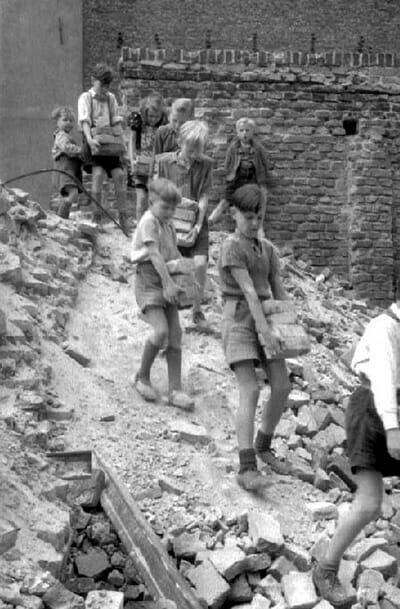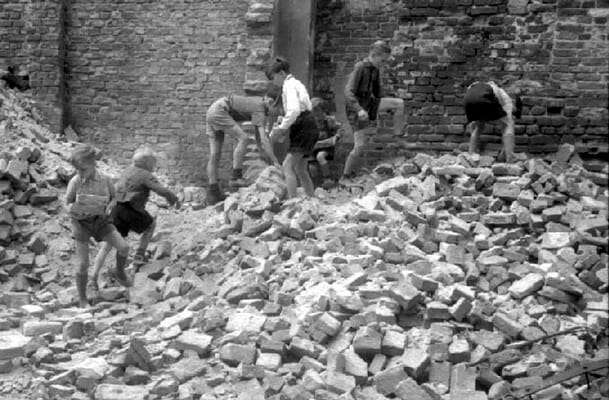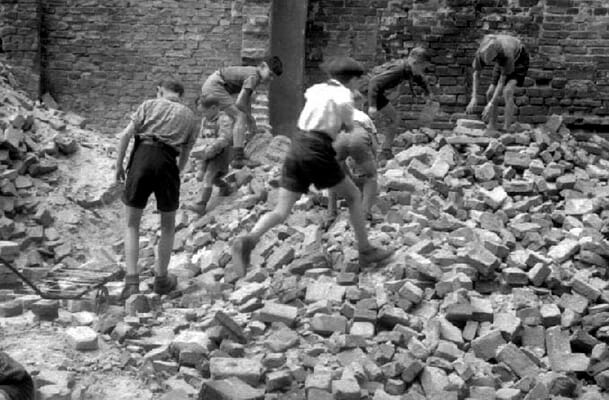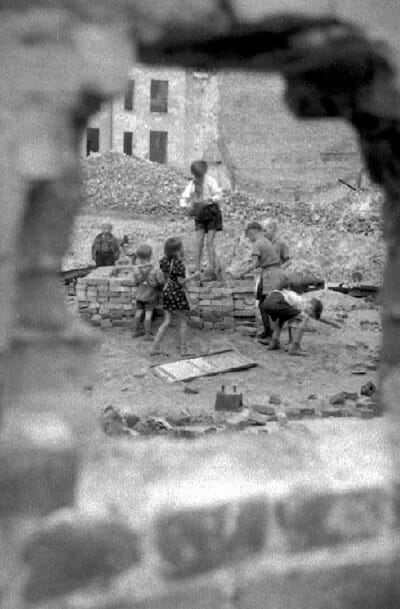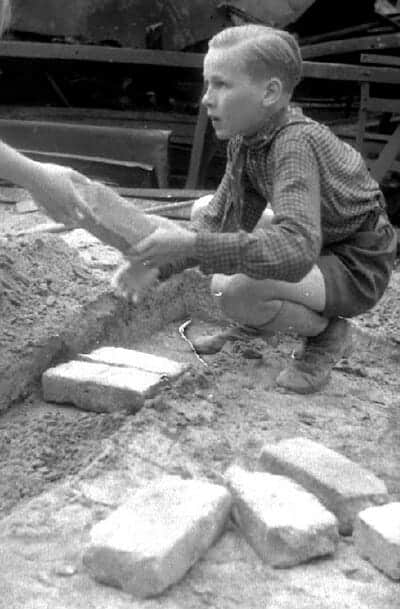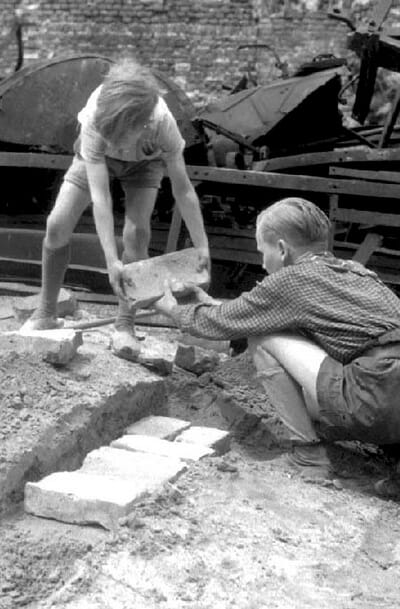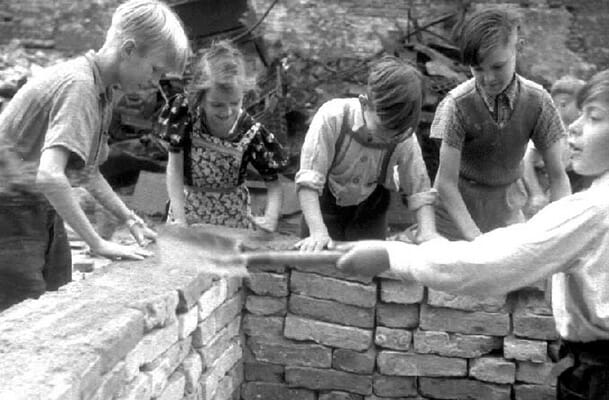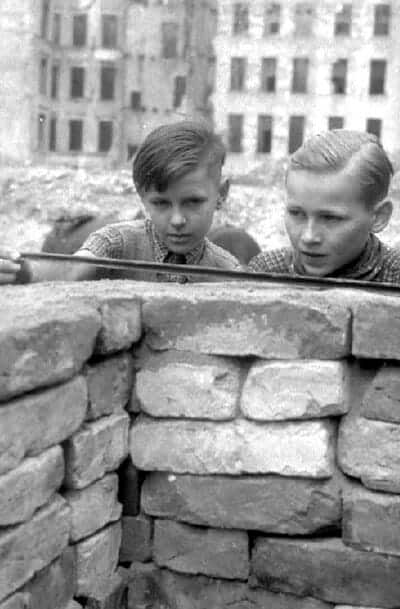How did the photo come about? So my grandparents, my children's grandparents and now me as a grandmother didn't have to carry bricks.
User request to mimikama.org
To all young people who don't know where their wealth comes from...
We were able to find the oldest version of the image montage on the private page of a district council member of a new-right dwarf party - with the text “Fridays for Future 1946”. It was published there in May 2020. From the following summer onwards, at least one meme site and three political Facebook pages from the right-wing spectrum [ here , here and here ] acted as multipliers. About a year later, the AfD jumped on the bandwagon to drive the pig through the village again. In a later version, the image was accompanied by the text “To all the kids who don’t know where your wealth comes from. These are your grandparents!” (sic) preceded.
The first generation creates wealth, the second manages wealth, the third studies art history, and the fourth completely degenerates.
Quote attributed to Otto von Bismarck
A grandchild generation of depraved art history students? A new right-wing party from Bonn probably sees it that way and used the image in a broadcast with the accompanying text: “Without megaphones and big slogans: This is how “Fridays for Future” tackled things in 1946.” Despite criticism, the parliamentary group leader adds again: “The To accuse the youth of 1946, with the knowledge of today, of recklessly overexploiting the planet while you, equipped with a smartphone, notebook, etc., make full use of the blessings of the affluent society - including annual vacations - is questionable behavior .”
The Bonn Fridays for Future members are rightly shocked: “Such a comparison is completely out of place and ridicules the destruction that the war brought back then. In addition, the caption degrades political protest itself, which is an important and fundamental cornerstone of our democracy.” The entire story can be read on the website of the press network for youth issues . But it's not just the content of the commented sharepic that needs to be questioned, but also how a photo was handled, which is of course subject to copyright.
About the photographer Walter Schulze
, the reverse also shows the rights holder of the original recordings: the Berlin City Museum . Mimikama establishes contact and learns many details during the correspondence. The picture actually dates from 1946 and was taken by Berlin photographer Walter Schulze. Under the name: “Post-war everyday life/Children collecting stones from a mountain of rubble” it is publicly accessible .
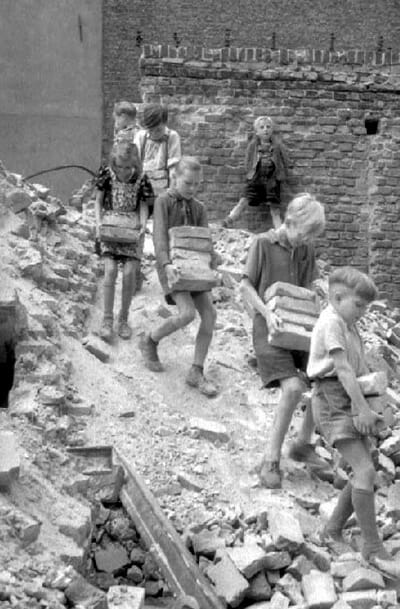
Unfortunately, little is known about the post-war photographer Walter Schulze. He was born on August 14, 1910 in Caputh near Berlin and probably returned to the destroyed capital as a war returnee. His first known recordings can be dated to 1945/46. In Berlin-Kreuzberg he founded PIA-Foto, a company for press, industrial and studio photography. He worked as a freelancer for the Berlin daily newspapers Telegraph and nacht-depesche .
As a press photographer, Walter Schulze had little concern for documentary distance. “Schulze produced images for the press that did not primarily depict misery. They provide information about everyday life at the time and they show it with a certain optimism that wanted to give people a bit of courage during this difficult time,” says Ines Hahn, the head of the photographic collection
“In the post-war period – in relation to the cost of living – film material and photographic paper are very expensive. Walter Schulze is forced to use his film material sparingly. In most situations he can only take one shot. The formal design of his photographs seems to be less important to him. Even when he has enough time to take a picture, he photographs spontaneously without paying attention to vanishing lines or anything similar. But that is precisely what gives his photos a special authenticity.”
Bodo Niemann in “Homecoming to Life”
The context of the recordings
The Berlin City Museum's holdings contain 28 negative films by Schulze in 35mm format, unfortunately without any contextual information. “So we can only use the images themselves and our knowledge of the post-war period for interpretation,” explains Ines Hahn. The image of children carrying bricks down a pile of rubble comes from one of these negative films.
Between seriousness and play: children on piles of rubble drag bricks and build walls. Series of images from the film reel SM 2016-4218.12 in the photo archive of the Berlin City Museum.
“From the other images in the film you can see that it is by no means a game. Rather, in the course of the pictures it is visible that the children are piling up the stones in stacks - as was common practice throughout the city at the time - so that they can be used again for the reconstruction of the largely destroyed city of Berlin or for repair work." Children, the well-known ones “Rubber women”, but also specialized companies and the Allies did their part to restore the infrastructure and viability of the city of Berlin.
Other photos by Schulze show children - often barefoot - playing in the rubble , on the way to school or with sweets from the "raisin bombers" during the blockade of West Berlin. Children were children back then, even if the need was often great and life was difficult. The food rations that people had to survive on during this time were limited. But anyone who helped clear away the rubble was entitled to a larger ration.
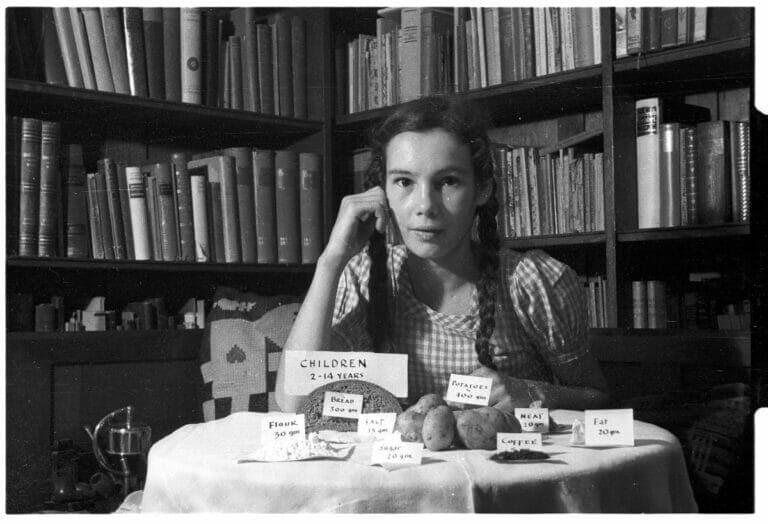
Legal and political
Photographs are protected within the EU under copyright law for up to 70 years after the photographer's death. Walter Schulze died in 1963, so his works are protected until the end of 2033. Only after this period is the work considered public domain and may be used without the consent of the rights holder.
This consent was not granted in this case: “The use of the photo is abusive and absolutely violates the goals and attitude of the Berlin City Museum,” says Robert Wein, head of the photo library . “I followed the keyword 'Fridays for future 1946' and also see how often Schulze's picture is shared. “Unfortunately, his picture in these articles has been taken out of its historical context and published without specifying the source and author,” Ines Hahn tells us.
The city museum has dealt very intensively with the period of creation and the work of the artist Schulze. The context and the accompanying comments are central to the question of whether the use of the image can be considered appropriate and legitimate. “It seems as if Schulze's image is being used for a polemic against the FFF movement, in which young people are campaigning against further destruction of the environment and a secure future. “Schulze’s picture acts as a kind of “symbolic image” for the reconstruction of Germany by the young generation at the time,” says Hahn.
It is further claimed that today's youth, who grew up in peace and prosperity, are not entitled to criticize the generation of that time and the environmental destruction they caused. “The image – used in this way – is intended to influence the social debate process by denying a “political opponent”, the FFF movement, the right to express themselves. In addition to the lack of naming of the author, as required by law, this is misuse.”
We at Mimikama would like to fully agree with this assessment.
Sources:
https://pressenetzwerk.de/blog/kinderarbeit-statt-jugenddemos/
https://sammlung-online.stadtmuseum.de/Home/Index?page=2&pId=13780797 (Collection of pictures by Walter Schulze)
https:/ /sammlung-online.stadtmuseum.de/Details/Index/1475457 (The misused photo in the collection archive)
Walter Schulze, Rolf Schneider (2005): Returning to life: Berlin 1945-1960. Building a publishing house.
This might also be of interest: FFF picture with garbage: Not Innsbruck, not FFF, but Naples.
Notes:
1) This content reflects the current state of affairs at the time of publication. The reproduction of individual images, screenshots, embeds or video sequences serves to discuss the topic. 2) Individual contributions were created through the use of machine assistance and were carefully checked by the Mimikama editorial team before publication. ( Reason )


